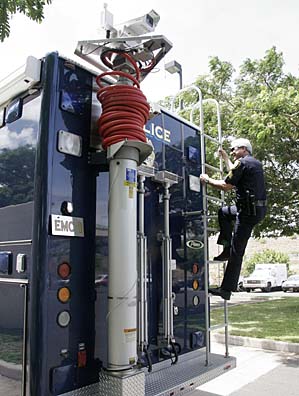
|
Communication
tower repairs due
$25 million will be used to fix
neglected police and fire sites
The city is spending $25 million to fix 24 communication towers that support police and fire department radio systems, Mayor Mufi Hannemann announced yesterday.
Hannemann's announcement was timed to be near tomorrow's fourth anniversary of the Sept. 11, 2001, terrorists attacks, but the aftermath of Hurricane Katrina was also on the minds of the mayor and other city officials.
"Some of these tower sites are where high winds could topple them," Hannemann said while showing a photo of a tower with a corroded support beam.
There is $4 million in the current year's budget to start work that Hannemann said he learned was needed shortly after taking office in January.
The metal towers, which have been in place for at least for 10 years, have not been maintained, said Gordon Bruce, the city's information technology director.
The city's approach to fixing the towers will be much like its "war on potholes": to first make urgent repairs to towers and leaky roofs on their support buildings, then to come back and do general maintenance, Bruce said.
Some work already has been completed, and some is going out for bid, Bruce said.
Hannemann said he plans to complete the work in four years.

|
"Cosmetic fixes will no longer do," he said. "We need the real thing."
"Police, fire and other first responders must be able to talk to each other," he said.
Hannemann also announced that the Oahu Civil Defense Agency, led by Director Bill Balfour, recently updated the city's emergency operations plan for the first time since 1991.
The old plan had no evacuation plan for Kapolei Hale or for a number of major city buildings where thousands of city employees work, Hannemann said.
The mayor also expressed condolences for the victims of Hurricane Katrina and urged Oahu residents to put together a hurricane preparedness kit with water, food, medicines and other key items needed to survive several days after a hurricane. "It's not a question of if, but when" a major hurricane will hit Hawaii, he said.
At least three of the 24 communications towers, at Kaaawa, Makakilo and Koko Head, will have to be replaced, Bruce said.
Bruce stressed that losing towers to high winds would not knock out the whole communication system, but create gaps in radio coverage. Those gaps could be filled on an emergency basis by portable transmitters and the Police Department's mobile communications vehicle, he said.
Emergency workers can also communicate via satellite phone and by using the city's fiber-optic cable network, Bruce said.
The $50 million police radio system was purchased 10 years ago but did not work well until it was moved under the Department of Information Technology about three years ago, Bruce said. Since then it has performed well, he said.
The Fire Department was added in June, making it possible for the first time for firefighters and police in the field to talk directly to each other by radio instead of through police and fire dispatchers, Bruce said.
www.co.honolulu.hi.us
E-mail to City Desk
[News] [Business] [Features] [Sports] [Editorial] [Do It Electric!]
[Classified Ads] [Search] [Subscribe] [Info] [Letter to Editor]
[Feedback]
